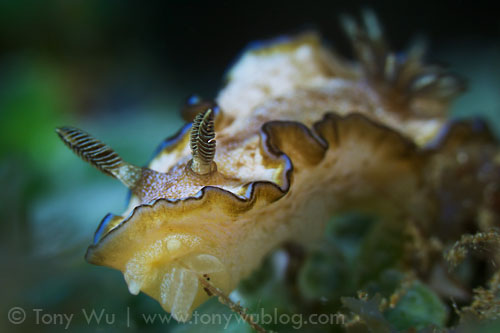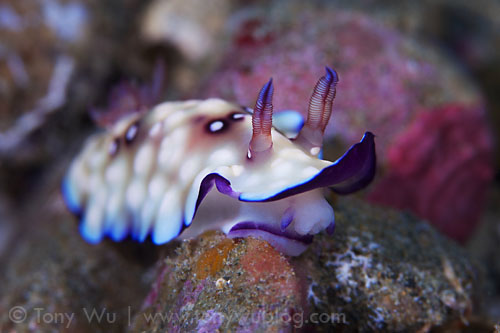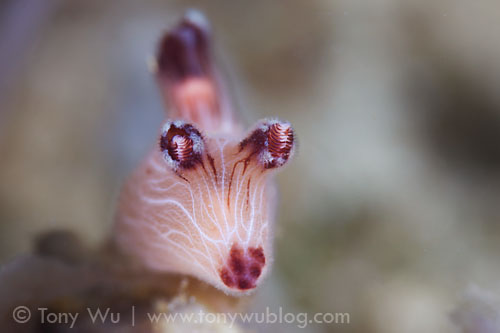While I was in Ambon, I spent most, but not all, of my time with the Totomega lens. On many dives, I carried a normal 100mm macro lens with me as well, which I turned to whenever I came across decent-sized nudibranchs like the ones below.

Glossodoris nudibranch moving along the reef

Chromodoris hintuanensis lifting its skirt
If you're a nudibranch fan, there are a lot(!) in Ambon Bay. Some are normal-size like these, but during my recent visit, there seemed to be many, many juvenile nudis, a number of which were barely the size of a grain of rice…if that.
I wasn't in the mood to squint, so I generally passed those by, but some of my friends from Thailand took excellent photos of some truly unusual Lilliputian sea slugs. So if you're good at searching through rubble, it's worth keeping an eye out for the teeny-tiny nudibranchs in Ambon.

A pair of Nembrotha cristata nudibranchs enjoying a morning tryst
I really love the following photo, because it's usually difficult to make Kentrodoris nudibranchs (which I refer to as puppy dog nudis) look good. [Note: Kentrodoris rubescens was renamed Jorunna rubescens in 2002. Thanks Ron!]
We found this juvenile in really shallow water (I think it was less than 5m) at the end of a dive. It happily sat on its perch, graciously affording each of us some private portrait time.

A baby Jorunna rubescens nudibranch
This Chromodoris nudi and others like it are pretty common all around the Indo-Pacific, so many people overlook them. I tried to impart a sense of glamour to an otherwise humdrum subject with a bit of dramatic lighting, sort of a film noir look:

A plump and juicy Chromodoris annae nudibranch
Some of my friends from Thailand are working on a book about nudibranchs, and Rani assigned me the "homework" of taking a pretty photograph of a Phyllidia nudibranch for her.
This was, of course, after I told her that I don't like Phyllidia nudibranchs and that I've never taken a photograph of one, because, well…they're boring lumps that just sit there and look stiff.
I can't refuse helping my friends though, so on my last dive with them, I settled down to photograph the nudibranch below.
As luck would have it, I may have found the only Phyllidia nudibranch in the world that travels non-stop at lightning speed (for a nudibranch). Seriously!
Every other Phyllidia I can recall ever seeing just sat there doing nothing, and the one time I want to take a photo of one, it crawled all over the rubble, ducking in-an-out of crevices, moving up-and-down the slope, twisting and turning, making sudden dashes, etc. Sheesh.
Anyway, here's my one and only, first and last, photograph of a Phyllidia:

Maybe the world's fastest Phyllidia ocellata!
They still look like dull lumps to me.